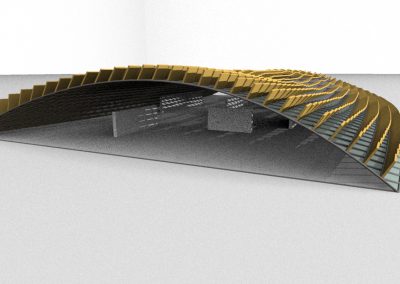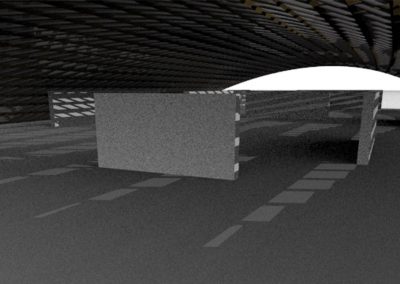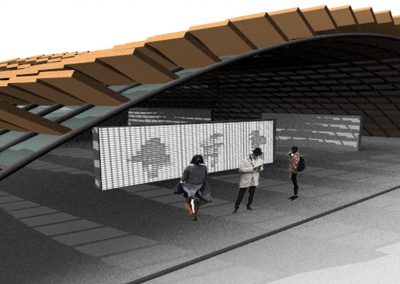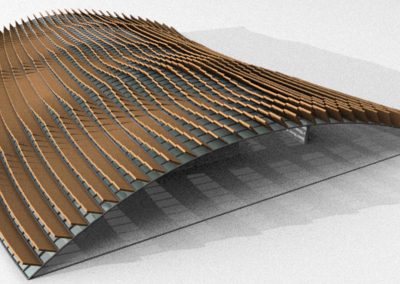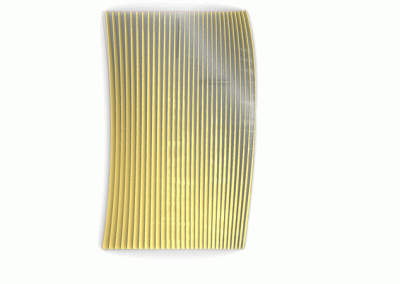Hareket Önsezili Sergi
Günümüzde teknolojinin gelişmesiyle birlikte, üretken tasarım yöntemlerinin kullanım alanları genişlemiştir. Üretilen projelere daha esnek ve adapte edilebilir çözümler getirebilmek mümkün olmaya başlamıştır. Farklı şartlarda bir araya gelme yöntemleri ile gelişen proje sürecinde, üretimden sonra da sürekli değişim gösterebilen (aslında üretimin hiç bitmediği ve bir döngüye girdiği) yapısal formlar oluşturulabilir. Oluşturulan bu form yapının hareketiyle de bir araya getirilerek farklı tecrübelere tanıklık etmemize olanak sağlar. Enerji talebini ve uygun şartları sağladığımızda (malzeme, sensor yerleri, yapay zekâ teknolojileri) otomasyonu sağlanmış yapı, dinamik bir şekilde geri dönüş vererek sürdürülebilirliği destekler. Kinetik bir örtü oluşturmak yapının enerji kullanımını, CO2 tüketimini önemli derecede düşürür ve pozitif bir iç çevre oluşturur. (Ceranic , Nguyen, 2018). Üretilen örtüde kullanılan malzeme olan akıllı camlar, kontrol edebildiğimiz girdilerin sayısını arttırır ve yapının yapay zekayla olan ilişkisini güçlendirir. Üretken tasarım sistemlerinde, bilgisayar programları ile tasarlama tasarımcının algoritma tanımlamasının ve biçim üretiminin önünü açar. Bu sayede kural tabanlı tasarımlar üretilebilir ve sürekli manuel olarak değil otomatikleştirilmiş bir sistem yaratılır. (Singh, 2012). Üretilen kabuk sergi düzeni, çevresel faktörler ve insan hareketiyle uyum içinde çalışır. Yapay zekanın öğrenebilme ve öğrenileni çeşitli zaman dilimlerinde gerçekleştirebilmesi sayesinde kabuk yaşayan bir varlık gibi davranır. Sergilenenlerin ışıktan etkilenebilme faktörlerine göre oluşan kabuktaki hareket, panellerin hareketi ve panellerin saydamlığındaki değişim olarak tanımlayabiliriz.
Motion-Sensitive Exhibition
Today, with the development of technology, the areas of use of generative design methods have expanded. It has become possible to bring more flexible and adaptable solutions to projects. During the project process, which develops with methods of coming together under different conditions, structural forms that can constantly change after production can be created. This formed form also comes together with the movement of the building. When energy demand and appropriate conditions are met (material, sensor locations, artificial intelligence technologies), the automated structure supports sustainability by giving a dynamic return. Creating a kinetic cover significantly reduces the energy use, CO2 consumption of the building and creates a positive internal environment. (Ceranic, Nguyen 2018). Smart glasses, the material used in the produced cover, increase the number of inputs we can control and strengthen the relationship of the building with artificial intelligence. In generative design systems, designing with computer programs paves the way for the designer’s algorithm definition and form generation. In this way, rule-based designs can be produced and an automated system is created rather than manually. (Singh 2012). The shell produced works in harmony with the exhibition layout, environmental factors and human movement. The shell behaves like a living creature thanks to the fact that artificial intelligence can learn and perform what is learned in various time periods. It can be defined as the movement in the shell, the movement of the panels and the change in the transparency of the panels, depending on the factors that can be affected by the light of the exhibited.
© 2021 Istanbul Technical University Graduate School, Department of Informatics, Architectural Design Computing Program. All Rights Reserved
